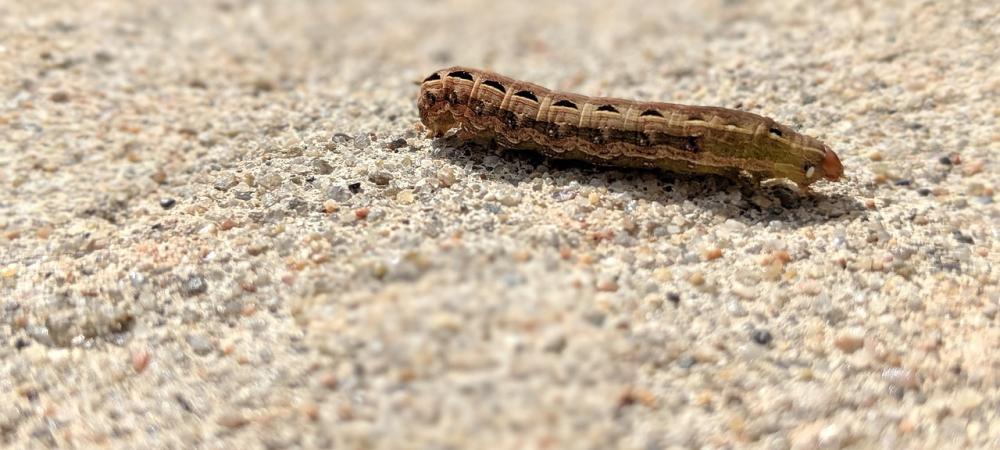3 Common Lawn-Destroying Insects in Maryland

Maryland’s summers are perfect for enjoying time outdoors, but those long, warm days also bring out a variety of pests that love to feast on your beautiful lawn. While you’re relaxing, some insects are hard at work, causing significant damage to your turf. Knowing how to identify and control these lawn-damaging pests will help you protect your lawn year-round.
In this guide, we’ll dive deep into the three most common lawn-destroying insects in Maryland, what their damage looks like, and how to keep your yard looking great.
1. Sod Webworms
Sod webworms are the larvae of small moths that typically emerge during late spring and summer, making them one of the most common pests in Maryland’s lawns. The adult moths are light brown with darker markings and about 1/2 to 3/4 inches long, but it’s their larvae that are the true culprits. These larvae are small, creamy-white caterpillars that are relentless in their destruction, feeding on your grass and leaving behind large brown patches.
What Sod Webworm Lawn Damage Looks Like
Sod webworm larvae chew on your grass blades, which causes your lawn to develop brown patches. These patches may look like they’ve been caused by drought or disease, but if you notice the damage occurring in clusters, sod webworms are likely the cause. As the larvae grow, they can cause large areas of your lawn to thin or die off.
- Discoloration: Sod webworms chew on grass blades, which causes yellow or brown patches to appear. The affected grass will often look dry, even if you’ve been watering consistently.
- Patchy Lawn: You might notice irregular patches that seem to spread across your lawn, which is a sign that the larvae are moving through your grass and feeding.
- Piles of Webs: If you spot small silk webs around your lawn, especially near the damaged areas, you’ve likely identified the source of the problem.
These pests typically target areas with less healthy grass, but they can spread and impact large sections of your lawn if left unchecked.
How to Prevent and Get Rid of Sod Webworms
The best way to keep sod webworms at bay is through proactive lawn care.
- Healthy Lawn Practices: Regularly mow your lawn and keep the grass at a reasonable length. Strong, healthy grass is less appealing to pests like sod webworms.
- Watering: Ensure your lawn is getting the right amount of water—enough to support growth but not so much that it attracts pests.
- Apply Beneficial Nematodes: Nematodes are microscopic organisms that kill webworm larvae in the soil. These natural predators are a great organic control option.
If you’re dealing with an active infestation, applying an insecticide with Bacillus thuringiensis (Bt) early in the larvae’s lifecycle is effective. For those looking for a more hands-off approach, consider professional lawn pest services, who provide surface insect control to handle infestations before they spread.
2. Chinch Bugs
Chinch bugs are small but mighty pests that primarily target warm-season grasses like tall fescue, zoysia, and Kentucky bluegrass. These tiny insects, which are about 1/6 inch in length, have grayish-black bodies and red legs. They are often active during warmer weather and are found in sunny spots, where they feast on grass roots. As they feed, they cause the grass to die from dehydration, and over time, the damage becomes extensive.
What Chinch Bug Lawn Damage Looks Like
Chinch bugs use their sharp beaks to suck the juices from your grass, ultimately depriving your turf of water. This causes grass blades to discolor and die, leaving behind patches of yellowed, scorched grass.
- Yellowing Grass: Chinch bugs suck moisture and nutrients from the grass, causing patches of yellow or brown grass that grow larger over time.
- Dry Patches: Even with regular watering, affected areas appear dry and scorched, making it look like you’ve got a serious drought problem on your hands.
- Presence of Bugs: While chinch bugs are tiny, they can be spotted in clusters when you inspect the affected areas. Simply part the grass and look for bugs feeding near the base of the blades.
Chinch bug infestations tend to affect established lawns, especially during hot, dry summers, and can cause long-term damage if not treated promptly.
How to Prevent and Get Rid of Chinch Bugs
- Ongoing Lawn Care: To prevent chinch bug infestations, it’s essential to keep your lawn healthy and well-maintained. Regular watering, aeration, and dethatching can make your turf less attractive to these pests.
- Proper Mowing: Cutting your grass too short weakens it and makes it more susceptible to chinch bug damage. Keep your grass at the recommended height for your grass type to keep it healthy.
- Fertilization: Apply slow-release fertilizers to keep the grass strong and help it recover from damage.
If chinch bugs are already in your lawn, you may need to apply a pesticide to kill them. Insecticides containing bifenthrin or permethrin are effective for chinch bug control, but these should be used according to the instructions to avoid harming beneficial insects. Many other turf-type pesticides are available, but their effectiveness can vary.
For the most reliable solution, consider enlisting a lawn care professional who can apply preventative treatments and conduct ongoing maintenance to ensure your lawn stays chinch-bug-free.
3. Cutworms
Cutworms (pictured above) are the larvae of various moth species and are known for their destructive nighttime feeding habits. These soft, smooth worms can grow up to 2 inches long and vary in color, including gray, brown, or green, depending on the species. Their primary food source? The tender young plants in your garden and grass, which they feed on by cutting them off at the base. They’re most active at night and hide in the soil during the day, making them a bit harder to spot.
What Cutworm Lawn Damage Looks Like
The damage caused by cutworms is typically noticeable in gardens and vegetable patches but can also affect your grass.
- Severed Grass: Cutworms chew through grass stems, cutting them at or just below the soil surface. As a result, you may find entire sections of grass lying flat or missing.
- Scorched Areas: The areas where cutworms have fed will look brown or dead, and you may even notice irregular, round patches of missing turf.
- Feeding Signs: If you carefully inspect the soil at night or early morning, you may see cutworms feeding on the base of your grass.
Cutworms are particularly dangerous to new lawns, as they target tender young grass. However, older lawns may be affected too, especially if they’ve been weakened by other pests or environmental stress.
How to Prevent and Get Rid of Cutworms
Preventing cutworms starts with early planting and good garden maintenance.
- Prepare the Soil: Till your garden soil before planting a new lawn to expose and kill any overwintering larvae.
- Remove Weeds: Cutworms thrive in areas with weeds or thick thatch, so keep your lawn clear of debris and maintain a clean surface.
- Use Physical Barriers: Place collars made of cardboard, aluminum foil, or plastic around vulnerable young plants to physically block cutworms from accessing the stems.
- Maintain Strong Grass: Healthy, mature grass is less likely to be harmed by cutworms. Keep your lawn properly fertilized and well-watered to encourage growth.
If you spot cutworms in your lawn, physically remove them and place them in soapy water. For significant infestations, the most effective solution is applying a pesticide labeled for cutworm control. If the infestation is too severe to handle on your own, consider reaching out to a lawn care professional for targeted treatments.
Additional Tips for Lawn Pest Management in Maryland
The best defense against common lawn insects is having a healthy lawn.
- Proper Aeration: Aerating your lawn once a year helps reduce compaction, allowing nutrients and water to reach deeper into the soil, which strengthens grass and makes it more resistant to pests.
- Fertilization: Use a balanced fertilization schedule that caters to your lawn’s specific needs, especially during the growing season. This will promote strong root growth and help your grass recover from pest damage.
- Early Detection: Check your lawn regularly for early signs of pest damage, such as discolored patches or uneven growth. The sooner you catch a problem, the easier it is to manage.
- Consult with Professionals: If you’re unsure whether you have a pest problem or need help with prevention, professional lawn care services can conduct inspections and provide tailored treatment plans.
Protect Your Lawn with Professional Surface Insect Control
The key to a healthy, thriving lawn is proactive care. By staying vigilant and following good lawn maintenance practices, you can minimize the risk of lawn pests. However, if you do notice signs of damage or want to be extra cautious, American Lawn & Tree Specialists offers expert surface insect control. Our treatments are designed to target and eliminate pests like sod webworms, chinch bugs, and cutworms, keeping your lawn lush and green throughout the year. We also offer an organic-based lawn care program that will provide your grass with the appropriate fertilization needed to stay strong and healthy.
Contact us today to learn more about our comprehensive lawn care programs and ensure your lawn stays protected from unwanted pests!
